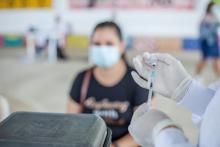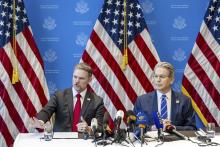The elections in the nation's capital marked an important step toward the national midterm elections in October, where Argentines must renew half of the seats in the Chamber of Deputies and a third of those in the Senate.
The strong performance of the ruling party in the legislative elections in Buenos Aires City (CABA) on Sunday gave a boost to Argentina's financial markets at the start of the week, given a consolidation of the policies implemented by libertarian President Javier Milei.
The elections in the nation's capital marked an important step toward the national midterm elections in October, where Argentines must renew half of the seats in the Chamber of Deputies and a third of those in the Senate.
"The legislative elections in Buenos Aires City rounded off a perfect week for the government, where the CPI (consumer price index) for April also fell to 2.8%, and the international trade truce between the United States and China created a better mood," said Roberto Geretto of Adcap Grupo Financiero.
The S&P Merval stock index gained 2.21% at a provisional close, after accumulating a 9.65% increase last week, while bonds on the local over-the-counter exchange gained an average of 0.6%, after rising 0.7% last week.
The improvement in local assets comes at a time when foreign markets were trading lower due to concerns about US debt and the rising deficit after Moody's downgraded its sovereign credit rating.
Operators and analysts estimate that the moderate support received by the ruling party at the polls creates an optimistic climate toward the consolidation of the economic program promoted by Milei.
"The bulk of this support has to do with Milei's figure, the ratification of a course, the ratification of a direction, and, of course, the tension that played out in this election with the leader of the non-Peronist space," said Shila Vilker, a public opinion analyst with the consulting firm Trespuntozero.
The peso traded quietly in the interbank round, gaining 0.18% to 1,141 per dollar, within a divergent range established between mid-April at 1,000 for buying and 1,400 for each dollar sold, established with the liberalization of the market.
Meanwhile, peso futures trading was improved to 1,167 units per dollar by the end of June and to 1,294.5 per dollar by the end of the year.
The government has stated that the central bank (BCRA) will not buy dollars from the market until the exchange rate reaches the lower limit, raising doubts about the country's ability to meet the reserve accumulation targets agreed upon with the International Monetary Fund (IMF) of US$4.4 billion by June 13.
Argentina recently reached a US$20 billion agreement with the IMF, which allowed the country to strengthen its Central Bank's reserves and loosen its strict foreign exchange controls (cepo).
"The economic scenario continues to develop under the logic of an economic program with a fiscal surplus, a clean and capitalized central bank, without monetary issuance, and with a financial system in which the State ceases to be a credit demander, which abruptly changes market dynamics," said analyst Salvador di Stefano.
In a radio interview, Milei said she will continue to promote measures to allow Argentines to use their accumulated undeclared foreign currency to boost the country's economy.
"It's like a money laundering scheme, but without paying taxes, obviously," the president said, noting that "it's not meant to raise revenue. It's meant, let's say, to free up (...) people to be free to use their money," he added, referring to the billions of dollars Argentines hold "under their mattresses" as a historical hedge against inflation.
Analysts and the government estimate that Argentines have approximately US$200 billion in savings outside the financial system.
The expected measures, which seek an "endogenous dollarization" of the economy, aim to relax controls and encourage the circulation of dollars in the market, analysts commented.
"The goal is for part of the dollars purchased by 'individuals' from exporters in the free exchange market (MULC) to remain in the financial system and supply (together with those generated by a new money laundering) a new round of dollar credit," said the consulting firm EcoGo.
"For now, since the start of Phase 3 (of the government plan), dollar deposits have increased by US$1.665 billion and cash in banks has decreased by US$814 million, in a context where dollar credit is beginning to pick up again. In other words, two out of every three dollars purchased by individuals remain in the system," he added.









